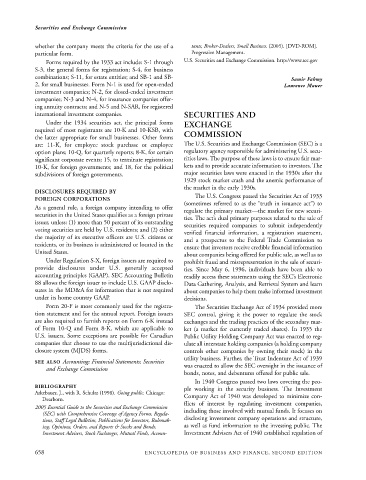Page 681 - Encyclopedia of Business and Finance
P. 681
eobf_S 7/5/06 3:21 PM Page 658
Securities and Exchange Commission
whether the company meets the criteria for the use of a tants, Broker-Dealers, Small Business. (2005). [DVD-ROM].
particular form. Progressive Management.
Forms required by the 1933 act include: S-1 through U.S. Securities and Exchange Commission. http://www.sec.gov
S-3, the general forms for registration; S-4, for business
combinations; S-11, for estate entities; and SB-1 and SB- Samir Fahmy
2, for small businesses. Form N-1 is used for open-ended Laurence Mauer
investment companies; N-2, for closed-ended investment
companies; N-3 and N-4, for insurance companies offer-
ing annuity contracts; and N-5 and N-SAR, for registered
international investment companies. SECURITIES AND
Under the 1934 securities act, the principal forms EXCHANGE
required of most registrants are 10-K and 10-KSB, with
the latter appropriate for small businesses. Other forms COMMISSION
are: 11-K, for employee stock purchase or employee The U.S. Securities and Exchange Commission (SEC) is a
option plans; 10-Q, for quarterly reports; 8-K, for certain regulatory agency responsible for administering U.S. secu-
significant corporate events; 15, to terminate registration; rities laws. The purpose of these laws is to ensure fair mar-
10-K, for foreign governments; and 18, for the political kets and to provide accurate information to investors. The
subdivisions of foreign governments. major securities laws were enacted in the 1930s after the
1929 stock market crash and the anemic performance of
the market in the early 1930s.
DISCLOSURES REQUIRED BY
FOREIGN CORPORATIONS The U.S. Congress passed the Securities Act of 1933
(sometimes referred to as the “truth in issuance act”) to
As a general rule, a foreign company intending to offer regulate the primary market—the market for new securi-
securities in the United States qualifies as a foreign private
ties. The act’s dual primary purposes related to the sale of
issuer, unless: (1) more than 50 percent of its outstanding
securities required companies to submit independently
voting securities are held by U.S. residents; and (2) either
verified financial information, a registration statement,
the majority of its executive officers are U.S. citizens or
and a prospectus to the Federal Trade Commission to
residents, or its business is administered or located in the ensure that investors receive credible financial information
United States.
about companies being offered for public sale, as well as to
Under Regulation S-X, foreign issuers are required to prohibit fraud and misrepresentation in the sale of securi-
provide disclosures under U.S. generally accepted ties. Since May 6, 1996, individuals have been able to
accounting principles (GAAP). SEC Accounting Bulletin readily access these statements using the SEC’s Electronic
88 allows the foreign issuer to include U.S. GAAP disclo- Data Gathering, Analysis, and Retrieval System and learn
sures in the MD&A for information that is not required about companies to help them make informed investment
under its home country GAAP. decisions.
Form 20-F is most commonly used for the registra- The Securities Exchange Act of 1934 provided more
tion statement and for the annual report. Foreign issuers SEC control, giving it the power to regulate the stock
are also required to furnish reports on Form 6-K instead exchanges and the trading practices of the secondary mar-
of Form 10-Q and Form 8-K, which are applicable to ket (a market for currently traded shares). In 1935 the
U.S. issuers. Some exceptions are possible for Canadian Public Utility Holding Company Act was enacted to reg-
companies that choose to use the multijurisdictional dis- ulate all interstate holding companies (a holding company
closure system (MJDS) forms. controls other companies by owning their stock) in the
utility business. Further, the Trust Indenture Act of 1939
SEE ALSO Accounting; Financial Statements; Securities
and Exchange Commission was enacted to allow the SEC oversight in the issuance of
bonds, notes, and debentures offered for public sale.
In 1940 Congress passed two laws covering the peo-
BIBLIOGRAPHY ple working in the security business. The Investment
Arkebauer, J., with R. Schultz (1998). Going public. Chicago: Company Act of 1940 was developed to minimize con-
Dearborn.
flicts of interest by regulating investment companies,
2005 Essential Guide to the Securities and Exchange Commission
(SEC) with Comprehensive Coverage of Agency Forms, Regula- including those involved with mutual funds. It focuses on
disclosing investment company operations and structure,
tions, Staff Legal Bulletins, Publications for Investors, Rulemak-
ing, Opinions, Orders, and Reports & Stocks and Bonds, as well as fund information to the investing public. The
Investment Advisers, Stock Exchanges, Mutual Finds, Accoun- Investment Advisers Act of 1940 established regulation of
658 ENCYCLOPEDIA OF BUSINESS AND FINANCE, SECOND EDITION

